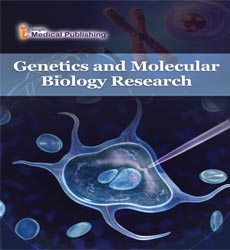Neuroblastoma and it's Molecular Biological Properties
Department of Molecular Biology, Calcutta University, India
- Corresponding Author:
- Sayan Bisvas
Department of Molecular Biology
Calcutta University, India
E-mail: bisvassayan@gmail.com
Received Date: August 25, 2021; Accepted Date: September 09, 2021; Published Date: September 16, 2021
Citation: Bisvas S (2021) Neuroblastoma and it’s Molecular Biological Properties. Genet Mol Biol Res Vol No: 5 Iss No:5:59
Copyright: © 2021 Bisvas S. This is an open-access article distributed under the terms of the Creative Commons Attribution License, which permits unrestricted use, distribution, and reproduction in any medium, provided the original author and source are credited.
Keywords
Nuroblastoma; Cancer
Neuroblastoma, the most well-known strong extracranial neoplasm in kids, is noteworthy for its clinical heterogeneity. Complex examples of hereditary anomalies associate to decide the clinical aggregate. The sub-atomic science of neuroblastoma is described by physically gained hereditary occasions that lead to quality overexpression (oncogenes), quality inactivation (growth silencer qualities), or adjustments in quality articulation. Intensification of the MYCN proto-oncogene happens in 20% to 25% of neuroblastomas and is a dependable marker of forceful clinical conduct. No other oncogene has been demonstrated to be reliably transformed or overexpressed in neuroblastoma, albeit unequal movements bringing about gain of hereditary material from chromosome groups 17q23-qter have been recognized in over half of essential cancers. A few youngsters have an acquired inclination to foster neuroblastoma, yet a familial neuroblastoma defenselessness quality has not yet been restricted. Reliable spaces of chromosomal misfortune, incorporating chromosome band 1p36 in 30% to 35% of essential cancers, 11q23 in 44%, and 14q23-qter in 22%, may recognize the area of neuroblastoma silencer qualities.
Modifications in the declaration of the neurotrophins and their receptors connect with clinical conduct and may mirror the level of neuroblastic separation before harmful change. Changes in the statement of qualities that manage apoptosis likewise associate with neuroblastoma conduct and may assist with clarifying the marvel of unconstrained relapse saw in a distinct subset of patients. Neuroblastoma, a cancer of postganglionic thoughtful neurons, is maybe the most interesting and confounding of adolescence neoplasms from both a clinical and a natural perspective. More than 500 new cases are analyzed in the United States each year, making this the most widely recognized strong cancer in youngsters [1]. Nonetheless, upgrades in malignancy treatment in the course of recent years littly affect the long haul endurance of youngsters with neuroblastoma.
Notwithstanding its protection from regular modalities of treatment, there are signs that neuroblastoma may be especially defenseless to imaginative ~ ways to deal with treatment. These pieces of information incorporate the great forecast of newborn children, even with dispersed infection (e.g., Stage IV-S), the inclination of the cancer to at times go through unconstrained relapse in patients, and its capacity to go through unconstrained or initiated separation to a harmless ganglioneuroma [2]. Consequently, superior comprehension of this sickness at the organic level might recommend new and conceivably more successful ways to deal with treatment. A lot of progress has been made in the beyond couple of years in propelling our information on human neuroblastoma at the cell and subatomic levels [3]. The hereditary inclination to this infection is becoming explained, a particular oncogene enhanced in neuroblastoma cells has prognostic importance, and the erasure of the short arm or chromosome 1 has been all the more exactly characterized. These and other later hereditary perceptions have added to our comprehension of cancer inclination, tumorigenesis, hereditary heterogeneity, growth movement, and forecast.
In this audit, the clinical and organic meaning of the accompanying major subjects will be tended to: 1) the hereditary qualities of human neuroblastoma including inherited inclination to neuroblastoma and protected cytogenetic irregularities in patients with this infection; and 2) cytogenetic and atomic anomalies in neuroblastoma cells- including an outline of cytogenetic irregularities, an audit of N-myc enhancement and other proof of oncogene initiation, and a conversation of chromosome lp erasure and loss of heterozygosity. At long last, ends and a few future possibilities will be introduced. Human neuroblastoma I-type cells secluded from cell lines in vitro are morphologically halfway between neuroblastic (N) cells, with properties of undeveloped sympathoblasts, and substratedisciple (S) cells having properties of early stage Schwann/glial/ melanocytic cells of the neural peak. I cells have biochemical elements of both N and S cells. We recommend that the I-type cell addresses a harmful neural peak undifferentiated organism. The most grounded proof on the side of this theory is that: (a) I cells can produce offspring that have neuronal properties, i.e., are submitted neuroblasts, or properties of nonneuronal, early stage neural peak determined cells; and (b) I-type cells can create multipotent I-type descendants, showing their ability for self-recharging, a component of immature microorganisms [4]. We report here that I-type cells, got from four unique human neuroblastoma cell lines and tentatively initiated to separate, lead to cells with unmistakable N or S cell aggregates, characteristic of I cell multipotentiality.
References
- Maris JM, Matthay KK (1999) Molecular biology of neuroblastoma. J Clin Oncol 17:2264-79.
- Arendonk KJV, Chung DH (2019) Neuroblastoma: Tumor Biology and Its Implications for Staging and Treatment. Children (Basel) 6:12.
- Maris JM (2010) Recent Advances in Neuroblastoma. N Engl J Med 362: 2202–2211.
- Dargeon HW (1962) Neuroblastoma. The J Pediatrics 61:456-471.
Open Access Journals
- Aquaculture & Veterinary Science
- Chemistry & Chemical Sciences
- Clinical Sciences
- Engineering
- General Science
- Genetics & Molecular Biology
- Health Care & Nursing
- Immunology & Microbiology
- Materials Science
- Mathematics & Physics
- Medical Sciences
- Neurology & Psychiatry
- Oncology & Cancer Science
- Pharmaceutical Sciences
